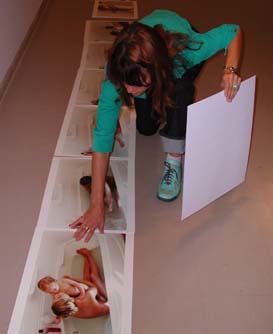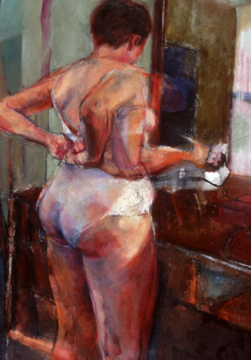 Click here to read the text about Dominique Rey by Pierre Raphaël Pelletier Click here to view photographs of the installation Click here to go back to the main Dominique Rey page.
|
 ABOVE: Dominique Rey with her photographs. DOMINIQUE REY:THE BATHERS by Cliff Eyland
Dominique Rey's work relates to recent Gallery One One One exhibitions and events about women's sexuality and feminism. An artist's talk by Carolee Schneemann was followed by a Charmaine solo show. Most recently "Bev Pike: The Spinster Project" happened. These events and exhibitions addressed feminist issues of the body from the perspective of three distinct generations of women: Carolee Schneemann, born in 1939, is a performance art pioneer whose sexually provocative work began before the great 1970s wave of feminism; Bev Pike was born in 1956, and identifies herself positively as a "spinster" and a feminist who aligns herself with a group of women at the social margins of contemporary life (the 'body' that interests her is, as she puts it, the 'body politic'); Charmaine, born around 1968, looks to pop icons like Madonna for inspiration. Like Madonna, Charmaine's feminism plays with tropes of pornography and women's sexual power, and the artist goes so far as to abjure the feminist label, believing that the very word "feminist" hinders her attempts at individuation. Dominique Rey, born in 1976, stakes out a position within debates about feminism and women's sexuality by making paintings and photographs about private female rituals like washing and dressing, but Rey, unlike Charmaine and many other contemporary women artists, accepts the term "feminism" without fuss, seeing her work as feminist work. Still, she would not identify with or take part in feminist activism the way Bev Pike does, nor would she align her sexuality with the provocations of a Schneemann (or, as mentioned below, provocateurs like the web cam queen Natasha Merritt). In this installation Rey lines up her 35 millimeter colour photographs on the wall tightly against each other as if they were high-definition excerpts from a motion picture. She includes bath photos of herself, of her friend Tracy pregnant, and of her friend Ginette with infant daughter Erica. Not included in this show but worth mentioning are her bath photographs of her mother Cécilia. When she graduated from art school three years ago, Rey was a painter who made photographs, but now she is a photographer who makes the occasional painting. She began photography in 1997, and had David McMillan, Larry Glawson and Laura Letinski as photography teachers. She is currently working in video, (in production at the time of this writing is a video of Rey bathing which will not be included in this exhibition) but it may be too early to speculate on a career trajectory for Rey, as if she has worked herself by stages and inevitably from painting to photography to video. Whatever her future, Rey has always brought a painter's sensitivity to colour, compositional sense, and a love of the still image to whatever medium she uses. ("The Bathers" is only one body of Rey's photographs: others include the "Mirror Series" shown this year at the Centre culturel franco-manitobain in St. Boniface, Manitoba, her home town.) Dominique Rey is an avid student of nineteenth-century French painting, and her approach to painting and photography is related to the era of impressionism, to Manet, and especially to Degas, the historical artist who instantly comes to mind in the presence of much of her painting. (It comes as no surprise that the National Gallery of Canada's Degas retrospective made a big impression on the teenaged Rey.)  ABOVE: A Rey painting from her Dress/Undress series oil on canvas 60"x42" 2000. (Not included in the exhibition.) Degas' painterly and photographic investigation of bathing females continues to conjure -- at least in art historical circles -- both admiration and contempt. Edward Snow, in his A Study of Vermeer traces all the way back to Degas' contemporary Huysmans the assertion that Degas' late bathers are the works of a misogynist. But it is Huysmans' own misogyny, says Snow, that is displaced onto Degas in the interest of Huysmans' own celebration of what Huysmans sees as Degas' iconoclasm [Snow p.177]. Snow regards the characterization of Degas as a misogynist to be a long-surviving and unfortunate stereotype: "The nudes of Degas' last period, especially" he says "seem in their quietly charged solitude to answer the same emotional and psychological pressures that underlie Vermeer's depictions of female privacy." [Snow p.27] Given what we know about Degas, one can't help but read his bathers as records of a performance in which intimacy between artist and model is not asserted but rather denied at close quarters, a situation that could have been, in fact, central to the erotic dynamic of a drawing session for Degas himself, not to mention innumerable other male artists who draw and have drawn female nudes. Edward Snow continues:
The Degas artist/model relationship expressed different power relationships than does Rey's positioning of gender and images of herself and other women in her work. Any portrayal of nudity in art is subject to speculation and accusations of exploitation, including in Rey's case self-exploitation, but I think that a close look at Rey's work will discourage such readings. Rey inserts herself as both artist and model in her work in order, I think, to identify herself with her models, a position that Degas could hardly have imagined. Like the art of Degas and Vermeer, however, (by the way, I make reference in this essay to art historical figures without apology) Rey's art seems to know its own distance from its subject, and like their art Rey's paintings and photographs address the female body and female identity (Rey does not make paintings or photographs of men) with a quiet humanity and eroticism. Her work is about female self-reflective looking. Because Rey often does duty as both artist and nude model she often creates a scenario that is perhaps doubly pleasing to the voyeur, but which curtails easy comparison to the male who makes his art based on female nudes. In her photographs of her women friends, Rey's subjects suggest an intimacy with the artist in their facial expressions and relaxed demeanor: this artist is trusted by her subjects. As for her depictions of herself, she is frank and understated. Dominique Rey is, we should be reminded, almost an exact contemporary of Natasha Merritt, whose book Digital Diaries [Merritt] includes pornographic shots of herself and her web cam bather sex partners. The Internet has made the term "explicit" denote imagery much more sexually charged than Rey's, but that is not to deny the eroticism of Rey's work: Rey's practice lies somewhere between Degas and Digital Diaries. Her images are both quotidian and erotic, both obviously posed and as unselfconsciously direct as possible. The work imagines as much as it portrays various states of womanhood in portrayals of females alone, pregnant, with a child, and middle-aged (i.e. in the photos of Rey's mother not shown in this exhibition). As the artist puts it:"My interest...pertain[s] to physical beauty, narcissism, and female rituals...with an emphasis on delving into the passage from narcissism, through self-definition, to self hood." [Rey] Bibliography Eyland, Cliff. Charmaine and Bev Pike:The Spinster Project . Online. Available: /schools/art/content/galleryoneoneone/111.html. Merritt, Natasha. Digital Diaries. New York:Taschen, 2000. Rey, Dominique. artist's statement from a brochure to accompany the exhibition Beyond the Image Winnipeg: Centre culturel franco-manitobain, unpaginated, 2002. Edward Snow, A Study of Vermeer . Berkeley: University of California Press 1994 Viso, Olga M. "Beauty and Its Dilemmas." Regarding Beauty ed. Neal Benezra, Olga M.Viso. Washington: Smithsonian Institution, 1999. NOTE: The works in the exhibition are "C" prints, 16"x20" each, all made in 2002. "Dominique Rey:The Bathers" 12 September to 4 October 2002. Opening reception: Thursday 12 September, 3 PM. Artist's talk: Wednesday 18 September, 12 NOON. The CD-ROM publication "Dominique Rey:The Bathers" includes images by Dominique Rey and an essay by curator Cliff Eyland. It also includes images and material about other Gallery One One One shows: $20.00 plus shipping. Total: $25.00 payable to Gallery One One One, School of Art, Main Floor, FitzGerald Building, University of Manitoba Fort Garry campus, Winnipeg, MB, CANADA R3T 2N2 TEL:204 474-9322 FAX:474-7605 For information please contact Robert Epp
eppr@ms.umanitoba.ca |